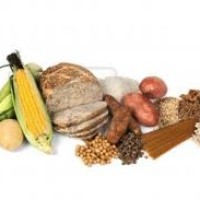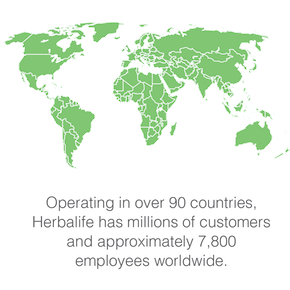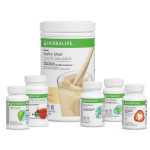
A healthy diet is not all about proteins.
It must include carbohydrates too.
So how many carbohydrates do you need?
I found a great article on the topic by Susan Bowerman.
Just what are carbs, anyway? As much as people talk about carbohydrates, you’d think that everyone actually knows where we get our “carbs” and how much carbohydrate we should be eating every day – or not. In truth, carbohydrates have been both praised and punished… in part because they’re largely misunderstood.
Carbs explained
When I say the word, “carb” you probably picture starchy foods like noodles, bread, rice and potatoes. And you’d be right. But you’d be just as right if fruits or vegetables popped into your head. And you’d still be right if you thought of sugar or honey or jam…or even a glass of milk. That’s because lots of foods supply carbohydrate – and it’s a good thing, too. Because when it comes to keeping your engine running, your body’s first choice of fuel isn’t fat or protein – it’s carbohydrate.
We get our carbs from a wide range of foods – but clearly some of them are healthier for us than others. That’s why you sometimes hear people refer to different carbs as being ‘good’ or ‘bad’. What they’re trying to say is that the “good” carbohydrates are those that are the least processed – foods like whole fruits, vegetables, dairy products, beans and whole grains. Dairy products also fall in this category because foods like lowfat milk, yogurt and cottage cheese deliver carbohydrate to the body in the form of naturally-occurring sugars.
The other reason these carbs are “good” is that they provide more than just energy to the body. There’s also vitamins and minerals tagging along – and in the case of fruits, vegetables, beans and grains, we also pick up some fiber and antioxidants, too.
On the other hand, the highly processed refined “bad” carbs – foods like sugars, pastries, white rice, and white flour breads, cereals, pasta and crackers – have little to offer the body beyond just calories. That’s why it’s best to steer towards the whole fruits, veggies, whole grains and beans to meet your carbohydrate needs.
How much carbohydrate do you need?
Sometimes people ask me how much carbohydrate they should eat every day. It’s not a simple question to answer. That’s because the amount of carbohydrate you need to eat depends, in large part, on how many calories you burn every day – but it also depends on how active you are. Generally speaking, it’s suggested that you aim to eat roughly half your calories from carbohydrate. But, if you do a lot of extensive exercise, you might need a bit more. Some people try a very low carb approach to weight loss, but it often backfires. When you cut your intake too far, you may not provide your body with enough carbohydrate to fuel your active lifestyle.
You can estimate your carbohydrate needs fairly simply. If you eat 1600 calories a day, about half of your calories should come from carbohydrate – which, in this case, would be about 800 calories a day from carbohydrate. Since every gram of carbohydrate has 4 calories, you’d divide your suggested carbohydrate calories by 4 to figure out how many grams you should eat per day. In this case, 800 calories of carbohydrate is 200 grams.
But keep in mind that you could eat through your carb budget pretty quickly if most of your carbs are supplied by less healthy foods like desserts, sodas, white bread, crackers and potato chips. So keep your eye on the carbohydrate prize – fruits, vegetables, whole grains, beans and dairy products should be the major sources of carbohydrate in your diet.
Here’s a guide to the amount of carbohydrate you should aim for daily, along with a list of some “healthy” carbohydrate foods with their carbohydrate content. Remember, though, that needs vary from person to person. If, for example, you do a lot of endurance exercise most days of the week, you may need a higher percentage of your daily calories from carbohydrate in order to get enough fuel for such a high level of activity.
Learn your personal carb needs
Daily calorie needs Suggested daily carbohydrate intake (50% of calories)
1200 150 grams
1400 175 grams
1600 200 grams
1800 225 grams
2000 250 grams
2200 275 grams
2400 300 grams
Essential guide to carb levels in common foods
Food |
Serving Size |
Carbohydrate (grams) |
| Fruits | ||
| Apricots | 3 whole | 12 |
| Apple | 1 medium | 25 |
| Blackberries | 1 cup (150g) | 14 |
| Blueberries | 1 cup (150g) | 21 |
| Cantaloupe | 1 cup cubes (150g) | 13 |
| Grapes | 1 cup (150g) | 27 |
| Grapefruit | ½ medium fruit | 11 |
| Kiwi | 1 average | 10 |
| Mango | ½ large | 25 |
| Nectarine | 1 medium | 15 |
| Orange | 1 medium | 18 |
| Papaya | 1 cup cubes (150g) | 16 |
| Peach | 1 medium | 15 |
| Pear | 1 medium | 27 |
| Pineapple | 1 cup, diced (150g) | 22 |
| Plums | 2 small | 15 |
| Strawberries | 1 cup, sliced (150g) | 13 |
| Tangerine | 1 medium | 12 |
| Watermelon | 1 cup balls (150g) | 12 |
| Vegetables (cooked, unless otherwise noted) | ||
| Artichoke | 1 medium | 14 |
| Asparagus | 1 cup (180g) | 8 |
| Beets | 1 cup (160g) | 16 |
| Broccoli, cooked, chopped | 1 cup (185) | 10 |
| Broccoli, raw | 1 cup (70g) | 4 |
| Brussels Sprouts | 1 cup (150g) | 11 |
| Cabbage, cooked | 1 cup (150g) | 8 |
| Cabbage, raw | 1 cup (70g) | 4 |
| Cauliflower, cooked, chopped | 1 cup (120g) | 5 |
| Cauliflower, raw, chopped | 1 cup (100g) | 5 |
| Carrots, cooked | 1 cup slices (150g) | 13 |
| Carrots, raw | 1 large | 7 |
| Celery | 2 large stalks | 4 |
| Corn | 1 ear | 14 |
| Cucumber | 1 medium | 4 |
| Eggplant | 1 cup cubes (100g) | 9 |
| Green beans | 1 cup (125g) | 10 |
| Green peas | 1 cup (160g) | 25 |
| Kale, cooked, chopped | 1 cup (130g) | 7 |
| Kale, raw, chopped | 1 cup (65g) | 5 |
| Leeks | 1 cup (100g) | 8 |
| Lettuce, shredded | 1 cup (50g) | 2 |
| Mushrooms, cooked | 1 cup (150g) | 8 |
| Mushrooms, raw | 1 cup sliced (70g) | 2 |
| Onion, cooked | 1 cup (200) | 21 |
| Peppers, chopped, cooked | 1 cup (135g) | 9 |
| Peppers, chopped, raw | 1 cup (150) | 9 |
| Spinach, cooked | 1 cup (180g) | 7 |
| Spinach, raw | 1 cup (30g) | 1 |
| Tomatoes, cooked | 1 cup (100g) | 13 |
| Tomatoes, raw, chopped | 1 cup (150g) | 7 |
| Winter squash | 1 cup (250g) | 22 |
| Zucchini (summer squash) | 1 cup (180g) | 5 |
| Grains, Beans, Starches | ||
| Beans (black, pinto, etc.) | ½ cup, cooked (85g) | 20 |
| Brown Rice | ½ cup, cooked (100g) | 22 |
| Lentils | ½ cup, cooked (100g) | 20 |
| Potato, baked | 1 medium | 36 |
| Quinoa | ½ cup, cooked (100g) | 20 |
| Spaghetti, whole wheat | ½ cup, cooked (70g) | 18 |
| Bread, Whole Grain | 1 slice | 14 |
| Dairy Products | ||
| Cottage cheese | 1 cup (225g) | 8 |
| Milk, nonfat or lowfat | 1 cup (250ml) | 12 |
| Soy Milk, plain | 1 cup (250ml) | 8 |
| Yogurt, plain, nonfat | 1 cup (250g) | 19 |
Written by Susan Bowerman, MS, RD, CSSD. Susan is a paid consultant for Herbalife.
*** Re-Blogged***
Tags: carbohydrates, carbs, how many carbohydrates, how many carbohydrates do I need, how many carbs





Leave A Reply (No comments so far)